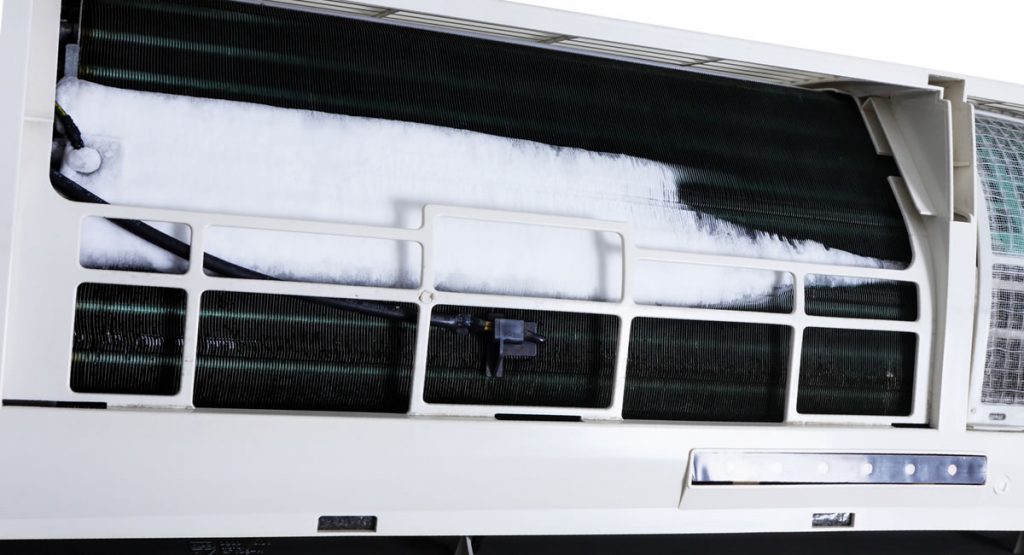Are you currently hunting for help and advice about Why Is Ice On My Outside Air Conditione?

Intro
Discovering that your air conditioner pipeline is frozen can be worrying, particularly throughout hot summer months when you rely upon your a/c one of the most. Understanding what to do in such a situation is critical to avoid additional damage to your cooling system and ensure your comfort inside your home.
Understanding the Causes
Several factors can add to the freezing of an air conditioning pipe. Comprehending these causes can assist you address the concern efficiently.
Lack of Airflow
One typical reason for a frozen air conditioning pipeline is inadequate air movement. When the air flow over the evaporator coil is restricted, it can trigger the coil to drop below freezing temperature level, bring about ice formation on the pipeline.
Low Refrigerant Levels
Insufficient refrigerant degrees in your air conditioner system can also result in a frozen pipe. Low refrigerant degrees can cause the stress in the system to drop, leading to the cold of dampness on the evaporator coil.
Winter Conditions
In chillier climates, freezing temperatures outside can contribute to the cold of a/c pipelines. If your AC unit is not effectively insulated or if there are leakages in the ductwork, chilly air can penetrate the system, causing the pipeline to ice up.
Dirty Air Filters
Filthy or clogged up air filters can limit air flow in your AC system, leading to different problems, consisting of an icy pipe. It's necessary to replace or clean your air filters consistently to make certain appropriate air movement and prevent ice build-up.
Signs of a Frozen AC Pipe
Recognizing the indicators of a frozen a/c pipeline is critical for timely activity.
Reduced Airflow
If you see a substantial decrease in air movement from your vents, it could suggest a frozen pipeline.
Ice Buildup on the Pipe
Visible ice buildup on the refrigerant line or the evaporator coil is a clear indication of an icy AC pipeline.
Odd Sounds from the Unit
Uncommon audios, such as hissing or bubbling, coming from your a/c system can signify that there's ice existing on the pipe.
Immediate Actions to Take
When faced with a frozen air conditioner pipe, it's important to act rapidly to avoid more damage to your cooling system.
Switching off the air conditioning
The primary step is to shut off your ac unit to stop the system from running and aggravating the problem.
Looking for Blockages
Evaluate the location around the interior unit for any kind of blockages that might be blocking air flow, such as furniture or curtains.
Defrosting the Pipe
You can use mild methods like placing towels taken in cozy water around the icy pipe to help thaw it gradually.
Preventive Measures
Taking preventive measures can help prevent future occurrences of an icy a/c pipeline.
When DIY Methods Fail
If your attempts to thaw the pipeline or address various other problems are unsuccessful, it's time to contact a professional.
Relevance of Hiring a Professional HVAC Technician
A certified HVAC service technician has the knowledge and tools essential to detect and fix concerns with your air conditioner system safely and efficiently.
Normal Maintenance Checks
Set up normal upkeep checks with a professional HVAC service technician to guarantee that your air conditioner system is running efficiently.
Altering Air Filters
Frequently replace or cleanse your air filters to stop air flow limitations and preserve optimum performance.
Shielding Exposed Pipes
If your air conditioning pipelines are revealed to chilly temperatures, consider protecting them to stop freezing throughout winter season.
Looking For Professional Help
If DIY approaches stop working to fix the problem or if you're uncertain regarding just how to continue, it's finest to seek assistance from a certified HVAC service technician.
Conclusion
Managing a frozen a/c pipeline can be a frustrating experience, however recognizing how to respond can help reduce damages and bring back convenience to your home. By understanding the causes, acknowledging the signs, and taking punctual action, you can efficiently address the concern and stop future occurrences.
What to Do If Your AC Line Is Frozen
Make Sure All Supply and Return Air Vents Are Open
If you notice problems with airflow, the first thing you should do is check your supply and return vents. Supply vents distribute clean, conditioned air throughout your home. As this air becomes stale, it’s pulled into the return vent, where it’s reconditioned before being sent back out through the supply vent.
When these vents are closed, air won’t flow in the home. Before examining your AC, check the vents in every room and ensure they’re all open.
Check for a Dirty Air Filter
Another possible cause of limited airflow is a dirty air filter. Your air conditioner’s filters catch elements you don’t want to breathe in, such as dirt and dust. Over time, filters can become clogged, ultimately blocking air from flowing in and out. The lack of airflow can then cause the entire coil to freeze and will completely restrict any air from moving through it. The AC may need to be powered off for one to two days to allow the coil to thaw after replacing the filter to allow proper functioning of the unit. This debris can also accumulate on your AC’s evaporator coil, requiring a more serious repair. In general, air filters should be cleaned regularly (about every two weeks).
Assess Your Outdoor Unit
In addition to checking your AC, assessing the outdoor unit is a good idea. Also known as the condensing unit, it works with your interior unit to release heat outside. An issue with the outdoor unit can result in rising internal temperatures.
Overgrown Shrubs or Clogged Leaves
From leaves and twigs to shrubs and debris, there’s no shortage of outdoor elements that can accumulate around your condensing unit. When these elements get lodged inside the unit, they can block airflow. Fortunately, removing the blockage can solve the problem.
Sounds of a Broken Fan
Shrubs and leaves aren’t the only things that can impede your outdoor unit’s airflow. If the fan is broken, the unit won’t be able to properly get rid of heat — which means the internal temperature won’t go down. First, make sure the fan is spinning. If it is, check for the following sounds of a broken fan:
Buzzing Rattling Screeching Hissing Clicking Preventative Measures
Nobody wants to deal with a frozen AC line. In addition to causing problems with your air conditioner, they require professional repairs. On the bright side, there are preventative measures you can take to help ensure this issue doesn’t arise in the first place.
https://www.coopergreenteam.com/blog/what-to-do-if-ac-line-frozen

Hopefully you enjoyed our part about Air Conditioner Frozen? How To Fix your Frozen AC Line. Thanks so much for spending some time to read our article post. Sharing is caring. You never know, you could be helping someone out. Many thanks for taking the time to read it.
Call Today